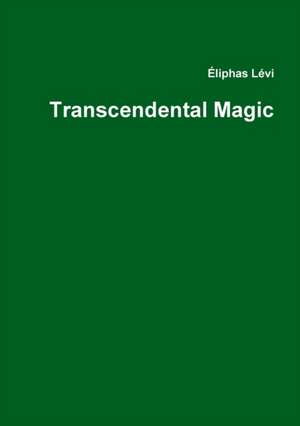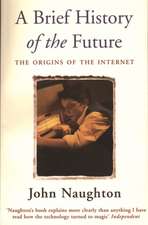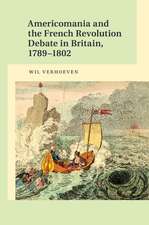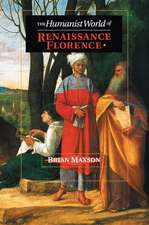Transcendental Magic
Autor Éliphas Lévien Limba Engleză Paperback – 24 sep 2018
| Toate formatele și edițiile | Preț | Express |
|---|---|---|
| Paperback (2) | 138.69 lei 6-8 săpt. | |
| A Yesterday's World Publishing – 24 sep 2018 | 138.69 lei 6-8 săpt. | |
| Cambridge University Press – 26 iun 2013 | 428.04 lei 6-8 săpt. |
Preț: 138.69 lei
Nou
Puncte Express: 208
Preț estimativ în valută:
26.54€ • 27.50$ • 22.15£
26.54€ • 27.50$ • 22.15£
Carte tipărită la comandă
Livrare economică 22 martie-05 aprilie
Preluare comenzi: 021 569.72.76
Specificații
ISBN-13: 9780993421051
ISBN-10: 0993421059
Pagini: 276
Dimensiuni: 148 x 210 x 15 mm
Greutate: 0.36 kg
Editura: A Yesterday's World Publishing
ISBN-10: 0993421059
Pagini: 276
Dimensiuni: 148 x 210 x 15 mm
Greutate: 0.36 kg
Editura: A Yesterday's World Publishing
Notă biografică
Éliphas Lévi (1810-1875) was the pseudonym used by Alphonse-Louis Constant after 1853, around the time he first published Doctrine and Ritual. An artist, poet, political activist and writer, and in his later years of life, occultist, here was a man who helped to fuel the occult revival and focused interest on spiritualism that swept through the Western world during the French Revolution and which would endure until the World Wars.
Constant was born into a poor working-class family, the son of a shoemaker. However, he demonstrated prodigy and high intellect from a young age, which inspired the priest of his local parish to send Constant to the Society of Saint Sulpice for a free seminary education where the boy learned Greek, Latin, and Hebrew. In his childhood, Constant tended to be a solitary child, more interested in drawing and painting. Later he would manage to support himself by selling his art. Though he entered the seminary on a track to priesthood, he was later compelled to drop out due to an alleged affair with an underage female student and his incompatible theological beliefs that were growing at odds with the Church.
Throughout his 20s and 30s, Constant was a radical socialist, a form of extreme left liberal political ideology of his time. He attributed his political leanings to his Christian love of humanity, in spite of such leanings tending to run contrary to the Church. While devoted to his faith, Constant was also critical of the Church, and spoke out against its conservative views on sexuality and its denigration of women.
In 1841, he was thrown in jail for his incendiary journalism and political activism. At trial, he made the following statement: "As a child of the people, I have suffered with the people and have dared to speak in the name of the people . . . . My only crime has been a deep love of mankind." Fellow Socialist activists, however, didn't quite understand him. While they supported his radical left political writings, they said this about him: "You possess devotion and energy, but you are mistaken when you speak to us of God, Spirit, and Love. We know only nature and matter."
During this time he also co-authored The Emancipation of Women with Flora Tristan (1803 - 1844), a feminist, socialist, writer, and outspoken champion for the working class.
By 1848, Constant was thrown in jail yet again for his socialist politics. By his late 30s, Constant switched from politics to occultism and at the age of 46, published what would become his masterpiece, Dogme et Ritual de la Haute Magie under the pen name Éliphas Lévi. However, he never fully gave up politics, as his political writings had him incarcerated in 1855, the interim year between the publication of Doctrine and Ritual. After Doctrine and Ritual, he published the History of Magic in 1860 when he was 50 and then Key to the Great Mysteries in 1861. For much of his life, he struggled financially, was sedentary and introverted, and spent most of his time pent up in his small rented Parisian apartment.
"Newton leads us back to Pythagoras," he said famously. Thematic across all of his occult works would be the proposition that magic is a science, that science itself inherits a legacy of occult traditions, and for any religion to be true, it must agree with philosophy.
Edited from Benebell Wen
Constant was born into a poor working-class family, the son of a shoemaker. However, he demonstrated prodigy and high intellect from a young age, which inspired the priest of his local parish to send Constant to the Society of Saint Sulpice for a free seminary education where the boy learned Greek, Latin, and Hebrew. In his childhood, Constant tended to be a solitary child, more interested in drawing and painting. Later he would manage to support himself by selling his art. Though he entered the seminary on a track to priesthood, he was later compelled to drop out due to an alleged affair with an underage female student and his incompatible theological beliefs that were growing at odds with the Church.
Throughout his 20s and 30s, Constant was a radical socialist, a form of extreme left liberal political ideology of his time. He attributed his political leanings to his Christian love of humanity, in spite of such leanings tending to run contrary to the Church. While devoted to his faith, Constant was also critical of the Church, and spoke out against its conservative views on sexuality and its denigration of women.
In 1841, he was thrown in jail for his incendiary journalism and political activism. At trial, he made the following statement: "As a child of the people, I have suffered with the people and have dared to speak in the name of the people . . . . My only crime has been a deep love of mankind." Fellow Socialist activists, however, didn't quite understand him. While they supported his radical left political writings, they said this about him: "You possess devotion and energy, but you are mistaken when you speak to us of God, Spirit, and Love. We know only nature and matter."
During this time he also co-authored The Emancipation of Women with Flora Tristan (1803 - 1844), a feminist, socialist, writer, and outspoken champion for the working class.
By 1848, Constant was thrown in jail yet again for his socialist politics. By his late 30s, Constant switched from politics to occultism and at the age of 46, published what would become his masterpiece, Dogme et Ritual de la Haute Magie under the pen name Éliphas Lévi. However, he never fully gave up politics, as his political writings had him incarcerated in 1855, the interim year between the publication of Doctrine and Ritual. After Doctrine and Ritual, he published the History of Magic in 1860 when he was 50 and then Key to the Great Mysteries in 1861. For much of his life, he struggled financially, was sedentary and introverted, and spent most of his time pent up in his small rented Parisian apartment.
"Newton leads us back to Pythagoras," he said famously. Thematic across all of his occult works would be the proposition that magic is a science, that science itself inherits a legacy of occult traditions, and for any religion to be true, it must agree with philosophy.
Edited from Benebell Wen
Cuprins
Biographical preface; Explanation of figures; Part I. The Doctrine of Transcendent Magic: Introduction; 1. The candidate; 2. The pillars of the temple; 3. The triangles of Solomon; 4. The tetragram; 5. The pentagram; 6. Magical equilibrium; 7. The fiery sword; 8. Realisation; 9. Initiation; 10. The Kabbalah; 11. The magic chain; 12. The great work; 13. Necromancy; 14. Transmutations; 15. Black magic; 16. Bewitchments; 17. Astrology; 18. Charms and philtres; 19. The stone of the philosophers; 20. The universal medicine; 21. Divination; 22. Summary and general key of the four secret sciences; Part II. The Ritual of Transcendent Magic: Introduction; 1. Preparations; 2. Magical equilibrium; 3. The triangle of pentacles; 4. The conjuration of the four; 5. The blazing pentagram; 6. The medium and the mediator; 7. The septenary of talismans; 8. A warning to the imprudent; 9. The ceremonial of initiates; 10. The key of occultism; 11. The triple chain; 12. The great work; 13. Necromancy; 14. Transmutations; 15. The sabbath of the sorcerers; 16. Witchcraft and spells; 17. The writing of the stars; 18. Philtres and magnetism; 19. The mastery of the sun; 20. The thaumaturge; 21. The science of the prophets; 22. The book of Hermes; Supplement to the ritual; Index.
Descriere
Descriere de la o altă ediție sau format:
Published in French in 1854, Lévi's popular work was translated into English by occult historian Arthur Edward Waite in 1896.
Published in French in 1854, Lévi's popular work was translated into English by occult historian Arthur Edward Waite in 1896.

























